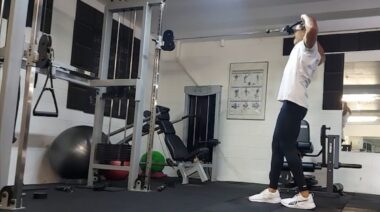You can’t go wrong with the back squat, deadlift, and bench press—the classic big three powerlifting movements. Train them regularly and you will gain strength, especially if you’re new to training.
But, not if these movements are causing you grief.
You can’t go wrong with the back squat, deadlift, and bench press—the classic big three powerlifting movements. Train them regularly and you will gain strength, especially if you’re new to training.
But, not if these movements are causing you grief.
Whether due to lingering chronic injuries or a lack of flexibility, I often see people continuing to squat, deadlift, or bench press even when they’re in pain, or aren’t able to lift with safe mechanics, because they don’t realize there are other options.
If this is you, consider laying off whatever movement is causing you issues and consider other ways to work the same muscles, and even build considerable strength, without straining your body as much as the big three sometimes can.
Alternatives to the Bench Press: 1. Dumbbell Floor Press
I often have clients with chronic shoulder problems who complain that bench pressing aggravates their shoulder pain. Then they switch to the floor press—which reduces the range of motion and protects their shoulders while still allowing them to build some serious strength and muscular endurance—and suddenly they are pain-free.
Alternatives to the Bench Press: 2. Barbell Floor Press
If you’re adamant that you still want to use the barbell, try the barbell floor press instead of using DBs. Again, the reduced range of motion and more stable position at the bottom of the movement sometimes makes all the difference for those who struggle during a traditional bench press.
Alternatives to the Deadlift: 1. Elevated Deadlift
If your problem during a traditional deadlift with a barbell is that your hamstrings are so tight you can’t maintain a neutral spine at the bottom of the lift, lifting your barbell three to five inches off the ground is often all you need to be able to deadlift with better form while getting the benefit of the movement.
Alternatives to the Deadlift: 2. Back Leg Elevated Single-Leg DB RDLs
Single leg RDLs are great for building posterior chain strength, especially single leg strength, and for and ironing out muscle imbalances—but sometimes poor balance then becomes your limitation.
Elevating your back leg on a box solves the balance limitation and also allows you to load up a little bit heavier than you would with a single leg RDL. Focus on a perfect hinge and a neutral spine as you’re doing these.
Alternatives to the Back Squat: 1. Goblet Squat to Box
Similar to a front squat (but doesn’t require the flexibility to get into a perfect rack position), the goblet squat allows you to keep a more upright position than the back squat. This makes it a perfect alternative for those who experience back pain during a back squat.
I especially like goblet squats to a box because it ensures a consistent depth and requires you to stand up without using momentum from the stretch reflex you get at the bottom of a traditional squat. This makes box squats a lot harder to lift heavy and safer for those whose joints lack stability.
The goblet squat to a box is also very useful for beginners, as it helps engrain perfect squat mechanics a little easier than the back squat.
Alternatives to the Back Squat: 2. Weighted Step-Ups
For those lacking hip or ankle mobility to squat to depth, but still want to build strength in their lower bodies, weighted step-ups are an effective way to build quad, hamstring, and glute strength safely without requiring a ton of flexibility.
There are tons of variations of the weighted step-up: farmer carry step-ups, front rack step-ups, barbell back rack step-ups, etc. Play around with what feels the most comfortable to you.
The take home message: Be safe. Don’t risk injuring yourself even more just because you want to lift like a powerlifter. Select movements that are wise for your body.






